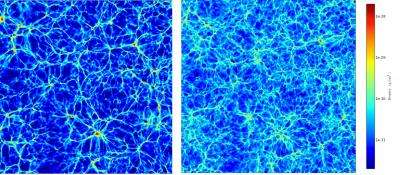These images represent numerical simulations comparing of the density of matter in a slice of the Universe with and without massive neutrinos. The two simulations started from the same initial conditions, with either massless neutrinos (left) or neutrinos with masses of 1.9 eV (right). In the massive neutrino case, matter is spread over a larger number of structures. Credit: Shankar Agarwal and Hume Feldman, University of Kansas
Physicists have long known that neutrinos are among the lightest and most evasive fundamental particles. Now a survey of the galaxies is helping to narrow down the neutrino mass even further. It seems that neutrinos are at best half as massive as previously estimated, according to an analysis appearing today in the journal Physical Review Letters.
The lower neutrino mass estimate is the result of a 3-dimensional survey of more than 700,000 galaxies called MegaZ DR7. Although neutrinos are very light and interact with matter very rarely, they are so numerous that they can have a significant effect on the evolution of the material distribution in the universe. The galactic distributions revealed in the MegaZ map appear consistent with a reduced upper limit of neutrino mass estimates.
There are restrictions on the information the map can provide, in part because there are three varieties of neutrinos (electron, muon, and tau neutrinos), each of which likely have different masses. As a result, MegaZ can only estimate the sum of the three neutrino masses. The galactic distribution suggests that the combined mass the three neutrino varieties is less than 0.28 electron volts.
Although the survey doesn't offer a lower limit of neutrino masses, it's clear from the detection of neutrinos coming from our sun, as well as from laboratory experiments, that neutrinos have at least some mass.
More information: Upper Bound of 0.28 eV on Neutrino Masses from the Largest Photometric Redshift Survey, Shaun A. Thomas, Filipe B. Abdalla, and Ofer Lahav, Phys. Rev. Lett. 105, 031301 (2010) - Published July 12, 2010, Download PDF (free)
Provided by American Physical Society





















